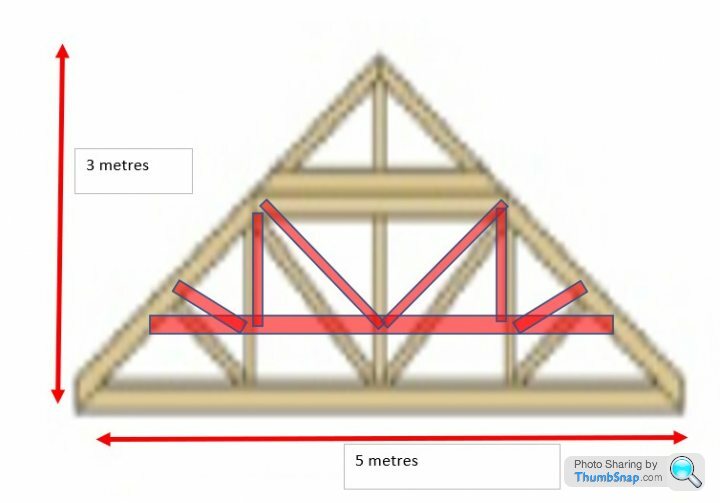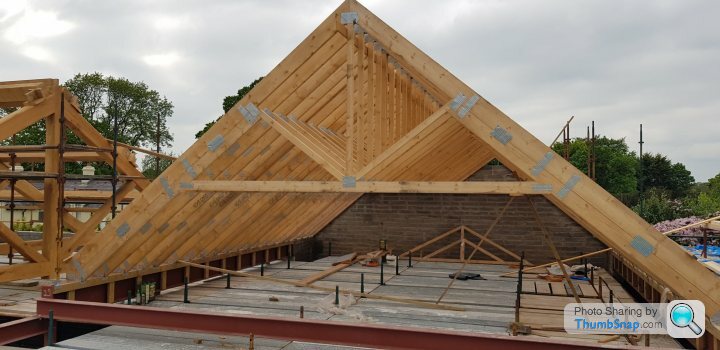Can I remove this roof truss? Pics
Discussion
I have a detached garage with quite a steep pitched roof, four trusses going lengthways spanning 5 metres. Truss design is like a piggyback with a triangle on top as shown. Proposed new bits in red, so raising up ONE of the four trusses by about 0.5m (to create more clearance in that area of the garage):

The ends of the trusses look like this, so I think they just rest on the top of the walls:
 [url]
[url]
The wood bits are currently held together with these perforated metal plate things:
 |https://thumbsnap.com/hkceiJ2Z[/url]
|https://thumbsnap.com/hkceiJ2Z[/url]
I've read that I should be able to raise the span by 1/3 of the height with no issues? The current wood all looks like 4"x2".
Ideally I'd like to just bolt in a load more 4"x2" in the positions marked in red then cut out the existing lower span.
Is this reasonable? It's a detached garage, not going to bring the house down if it ends up a bit sketchy. I don't really need a structural engineer for this do I? Cheers

The ends of the trusses look like this, so I think they just rest on the top of the walls:
 [url]
[url]The wood bits are currently held together with these perforated metal plate things:
 |https://thumbsnap.com/hkceiJ2Z[/url]
|https://thumbsnap.com/hkceiJ2Z[/url]I've read that I should be able to raise the span by 1/3 of the height with no issues? The current wood all looks like 4"x2".
Ideally I'd like to just bolt in a load more 4"x2" in the positions marked in red then cut out the existing lower span.
Is this reasonable? It's a detached garage, not going to bring the house down if it ends up a bit sketchy. I don't really need a structural engineer for this do I? Cheers
Altering gang nail trusses is a difficult process, as they don't often have much spare in their design and do not work in the same way a traditional cut roof does. These sort of modifications require building regulation approval and often cause issues during the house sale process.
Remedial repairs are often difficult to justify and implement.
Remedial repairs are often difficult to justify and implement.
Grumbly said:
Altering gang nail trusses is a difficult process, as they don't often have much spare in their design and do not work in the same way a traditional cut roof does. These sort of modifications require building regulation approval and often cause issues during the house sale process.
Remedial repairs are often difficult to justify and implement.
The gang nail bits don't look very strong anyway, presumably they are used for speed, so I think that's why I'm suggesting I bolt in new trusses with big coachbolts etc. ?Remedial repairs are often difficult to justify and implement.
The fact you seem to want to take on this work but appear to have minimal building knowledge is quite scary. The best/safest option (however expensive) would be to remove the roof and change its design. You can then have whatever height and space you need, a nice building regs certificate to wave at any buyers and no issues down the line.
Largechris said:
I've read that I should be able to raise the span by 1/3 of the height with no issues? The current wood all looks like 4"x2".
That guidance is for a cut roof and not trusses.For a 5m span on a cut roof the rafters would need to be a minimum of 50x175 so yours are woefully undersized.
As already said, you need a structural engineer
smokey mow said:
Largechris said:
I've read that I should be able to raise the span by 1/3 of the height with no issues? The current wood all looks like 4"x2".
That guidance is for a cut roof and not trusses.For a 5m span on a cut roof the rafters would need to be a minimum of 50x175 so yours are woefully undersized.
As already said, you need a structural engineer
I can do the structural calculations myself I'm a qualified engineer. Just looks like this is the quick way to move one rafter a tiny bit upwards?
I'm not a structural engineer nor do I have any qualifications in this area. But as a lay person this intuitively seems like a bad idea.
At the moment you have the force from the weight of the roof being born mostly by the three central vertical bearers which are 'in line' with the force (ie; in compression).

But it seems you are proposing that the entire weight of the roof will be born by the outside lower section of the roof. These go from bearing almost none of the load, to bearing all of it. And they are also having to bear the force 'in bending' as Grumbly says.
The force is not in line with the timber, it's vertically down (because of gravity)

Your design doesn't add any reinforcement to the areas which are now bearing all the load.
At the moment you have the force from the weight of the roof being born mostly by the three central vertical bearers which are 'in line' with the force (ie; in compression).

But it seems you are proposing that the entire weight of the roof will be born by the outside lower section of the roof. These go from bearing almost none of the load, to bearing all of it. And they are also having to bear the force 'in bending' as Grumbly says.
The force is not in line with the timber, it's vertically down (because of gravity)

Your design doesn't add any reinforcement to the areas which are now bearing all the load.
Edited by walamai on Friday 5th November 14:28
walamai said:
I'm not a structural engineer nor do I have any qualifications in this are. But as a lay person this intuitively seems like a bad idea.
At the moment you have the force from the weight of the roof being born mostly by the three central vertical bearers which are 'in line' with the force (ie; in compression).

But it seems you are proposing that the entire weight of the roof will be born by the outside lower section of the roof. These go from bearing almost none of the load, to bearing all of it. And they are also having to bear the force 'in bending' as Grumbly says.
The force is not in line with the timber, it's vertically down (because of gravity)

Your design doesn't add any reinforcement to the areas which are now bearing all the load.
This isn't really how trusses work, the members are connected and act together so either in compression or tension with very little bending. Once you cut the truss they have to act like a traditional cut roof with the members being subject to bending loads which the are not adequately sized to accept.At the moment you have the force from the weight of the roof being born mostly by the three central vertical bearers which are 'in line' with the force (ie; in compression).

But it seems you are proposing that the entire weight of the roof will be born by the outside lower section of the roof. These go from bearing almost none of the load, to bearing all of it. And they are also having to bear the force 'in bending' as Grumbly says.
The force is not in line with the timber, it's vertically down (because of gravity)

Your design doesn't add any reinforcement to the areas which are now bearing all the load.
walamai said:
I'm not a structural engineer nor do I have any qualifications in this are. But as a lay person this intuitively seems like a bad idea.
At the moment you have the force from the weight of the roof being born mostly by the three central vertical bearers which are 'in line' with the force (ie; in compression).

But it seems you are proposing that the entire weight of the roof will be born by the outside lower section of the roof. These go from bearing almost none of the load, to bearing all of it. And they are also having to bear the force 'in bending' as Grumbly says.
The force is not in line with the timber, it's vertically down (because of gravity)

Your design doesn't add any reinforcement to the areas which are now bearing all the load.
Thank you for that helpful reply. Yes, I think this was maybe my question, in that as I understand it with a "cut" roof you can happily move the rafter upwards by upto a third of the height, as per this guide:At the moment you have the force from the weight of the roof being born mostly by the three central vertical bearers which are 'in line' with the force (ie; in compression).

But it seems you are proposing that the entire weight of the roof will be born by the outside lower section of the roof. These go from bearing almost none of the load, to bearing all of it. And they are also having to bear the force 'in bending' as Grumbly says.
The force is not in line with the timber, it's vertically down (because of gravity)

Your design doesn't add any reinforcement to the areas which are now bearing all the load.

So the end bits look more like this, coachbolts, gorilla glue etc.:

In other words I'm replacing a truss with a cut roof design in that area?
Grumbly said:
This isn't really how trusses work, the members are connected and act together so either in compression or tension with very little bending. Once you cut the truss they have to act like a traditional cut roof with the members being subject to bending loads which the are not adequately sized to accept.
Where do the bending loads occur - which bits are the 'members' in bending? In my naïve view of things I thought the bending would be about where my blue arrows are in the second picture. (Maybe a bad way to say it - not like there is a force applied at that point exactly. But it I looked at the roof in two years I'd expect to find a bend in that bit  )
)Not challenging what you're saying, just interested to learn.
ETA: Actually I think I see what you are saying. The whole truss structure is a rigid, so forces are transferred through all the elements. My first diagram would only be correct if things were just sitting there and held together by gravity. But I think the second diagram kind of shows the problem being introduced?
Edited by walamai on Friday 5th November 14:49
There is very little bending in the members until the truss is cut. Once cut there are bending and shear loads in all the members, the critical point will be, as you have correctly pointed out, the short section of rafter between the wall plate and the ceiling tie.
This short section of rafter now effectively acts as a cantilever with half of the dead and live load supported by the truss acting as a point load at the tip.
This short section of rafter now effectively acts as a cantilever with half of the dead and live load supported by the truss acting as a point load at the tip.
A quick search for raised tie roof truss found this picture
https://murdockrooftrusses.com/wp-content/uploads/...

Note the way the lower section of the rafter is expanded with another section of timber.
https://murdockrooftrusses.com/wp-content/uploads/...

Note the way the lower section of the rafter is expanded with another section of timber.
Largechris said:
smokey mow said:
Largechris said:
I've read that I should be able to raise the span by 1/3 of the height with no issues? The current wood all looks like 4"x2".
That guidance is for a cut roof and not trusses.For a 5m span on a cut roof the rafters would need to be a minimum of 50x175 so yours are woefully undersized.
As already said, you need a structural engineer
I can do the structural calculations myself I'm a qualified engineer. Just looks like this is the quick way to move one rafter a tiny bit upwards?
Gassing Station | Homes, Gardens and DIY | Top of Page | What's New | My Stuff






